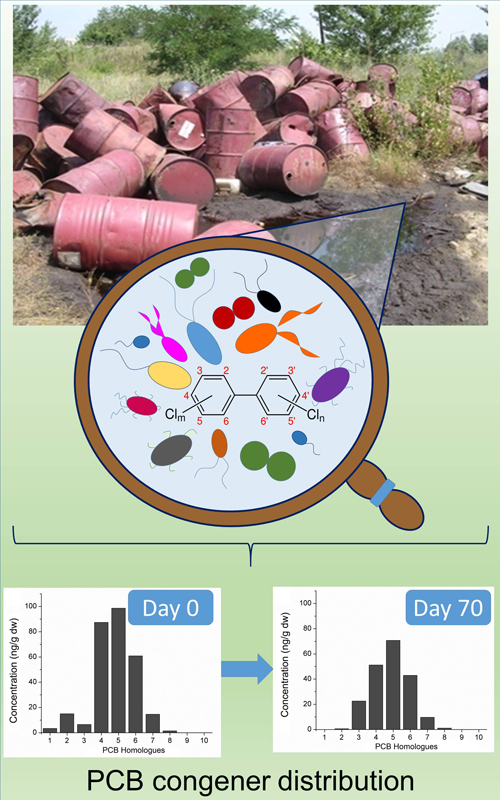Bioremediation of river sediment polluted with polychlorinated biphenyls: A laboratory study Scientific paper
Main Article Content
Abstract
Persistent organic pollutants (POPs) are lipophilic, constant and bioaccumulative toxic compounds. In general, they are considered resistant to biological, photolytic, and chemical degradation with polychlorinated biphenyls (PCBs) belonging to these chemicals. PCBs were never produced in Serbia, but they were imported and mainly used in electrical equipment, transformers, and capacitors. Our study aimed to analyse sequential multi-stage aerobic/anaerobic microbial biodegradation of PCBs present in the river sediment from the area known for long-term pollution with these chemicals. The study with an autochthonous natural microbial community (NMC model system) and NMC augmented with allochthonous hydrocarbon-degrading (AHD) microorganisms (isolated from location contaminated with petroleum products) (NMC-AHD model system) was performed in order to estimate the potential of these microorganisms for possible use in future bioremediation treatment of these sites. The laboratory biodegradation study lasted 70 days, after which an overall >33 % reduction in the concentration of total PCBs was observed. This study confirmed the strong potential of the NMC for the reduction of the level of PCBs in the river sediment under alternating multi-stage aerobic/anaerobic conditions.
Downloads
Metrics
Article Details

This work is licensed under a Creative Commons Attribution-NonCommercial-NoDerivatives 4.0 International License.

Authors retain copyright and grant the journal right of first publication with the work simultaneously licensed under a Creative Commons Attribution license 4.0 that allows others to share the work with an acknowledgement of the work's authorship and initial publication in this journal.
References
L. Xu, Y. Teng, Z. G. Li, J. M. Norton, Y. M. Luo, Sci. Total Environ. 408 (2010) 1007 (https://doi.org/10.1016/j.scitotenv.2009.11.031)
M. Matthies, K. Solomon, M. Vighi, A. Gilman, J. V. Tarazona, Environ. Sci.- Proc. Imp. 18 (2016) 1114 (https://doi.org/10.1039/c6em00311g)
A. V. B. Reddya, M. Moniruzzamana, T. M. Aminabhavi, Chem. Eng. J. 358 (2019) 1186 (https://doi.org/10.1016/j.cej.2018.09.205)
R. Villemur, Philos. Trans. R. Soc. Lond. B Biol. Sci. 368 (2013) 20120319 (https://doi.org/10.1098/rstb.2012.0319)
M. Diez, J. Soil Sci. Plant Nut. 10 (2010) 244 (https://doi.org/10.4067/S0718-95162010000100004)
P. I. Nikel, D. Pérez-Pantoja, V. de Lorenzo, Philos. Trans. R. Soc. Lond. B Biol. Sci. 368 (2013) 20120377 (https://doi.org/10.1098/rstb.2012.0377)
F. Khalid, M. Z. Hashmi, N. Jamil, A. Quadir, M. I. Ali, Environ. Sci. Pollut. Res. 28 (2021) 10474 https://doi.org/10.1007/s11356-020-11996-2).
L. Passatore, S. Rossetti, A. A. Juwarkar, A. Massacci, J. Hazard. Mater. 278 (2014) 189 (https://doi.org/10.1016/j.jhazmat.2014.05.051)
P. K. Arora, Microbial Metabolism of Xenobiotic Compounds, Springer, Singapore, 2019, pп. 165–188 (https://doi.org/10.1007/978-981-13-7462-3)
M. Seeger, M. Hernández, V. Méndez, B. Ponce, M. Córdova, M. González, J. Soil Sci. Plant Nut. 10 (2010) 320 (https://doi.org/10.4067/S0718-95162010000100007)
Stockholm Convention on POPs. Text of the Convention, http://www.pops.int/TheConvention/Overview/TextoftheConvention/tabid/2232/Default.aspx (аccessed 17 December 2021)
M. A Ashraf, Environ. Sci. Pollut. R. 5 (2015) 4223 (https://doi.org/10.1007/s11356-015-5225-9)
EPA Persistent Organic Pollutants: A Global Issue, A Global Response, https://www.epa.gov/international-cooperation/persistent-organic-pollutants-global-issue-global-response (аccessed 17 December 2021)
Stockholm convention on POPs. The 12 initial POPs under Stockholm convention, http://www.pops.int/TheConvention/ThePOPs/The12InitialPOPs/tabid/296/Default.aspx (аccessed 17 December 2021)
D. L. Bedard, K. M. Ritalahti, F. E. Löffler, Appl. Environ. Microb. 73 (2007) 2513 (https://doi.org/10.1128/AEM.02909-06)
J. Wiegel, Q. Wu, FEMS Microbiol. Ecol. 32 (2000) 1 (https://doi.org/10.1111/j.1574-6941.2000.tb00693.x)
NIP-National Implementation Plan for the implementation of the Stockholm Convention, the Ministry of Environment and Spatial Planning of the Republic of Serbia, 2010
V. P. Beškoski, G. Gojgić - Cvijović, J. Milić, M. Ilić, S. Miletić, T. Šolević, M.M. Vrvić, Chemosphere 83 (2011) 34 (https://doi.org/10.1016/j.chemosphere.2011.01.020)
G. Dević, S. Sakan, D. Đorđević, Environ. Sci. Pollut. Res. 23 (2016) 282 (https://doi.org/10.1007/s11356-015-5808-5)
ISO 16703: Soil Quality – Determination of Content of Hydrocarbon in the Range C10 to C40 by Gas Chromatography, 2004
DIN EN 14345: Characterization of Waste. Determination of Hydrocarbon Content by Gravimetry, 2004
R. Margesin, F. Schinner, Manual for soil analysis-monitoring and assessing soil bioremediation, Springer-Verlag, Berlin, 2005, pp. 47–95 (https://doi.org/10.1007/3-540-28904-6)
M. Pansu, J. Gautheyrou, Handbook of soil analysis- mineralogical, organic and inorganic methods, Springer-Verlag, Berlin, 2006 (https://doi.org/10.1007/978-3-540-31211-6)
D. Leys, L. Adrian, H. Smidt, Philos. Trans. R. Soc., B 368 (2013) 20120316 (https://doi.org/10.1098/rstb.2012.0316)
C. J. Hurst, R. L. Crawford, G. R. Knudsen, M. J. McInerney, L. D. Stetzenbach. Manual of Environmental Microbiology, 2nd ed., ASM Press, Washington DC, 2002, p. 934 (ISBN 978-1555811990)
G. D. Gojgic-Cvijovic, J. S. Milic, T. M. Solevic, V. P. Beskoski, M. V. Ilic, L. S. Djokic, T. M. Narancic, M. M. Vrvic, Biodegradation 23 (2012) 1 (https://doi.org/10.1007/s10532-011-9481-1)
NCBI – The national center for biotechnology information, Nucleotide database, https://www.ncbi.nlm.nih.gov (accessed 17 December 2021)
I. Liska, F. Wagner, M. Sengl, K. Deutsch, J. Slobodnik, Joint Danube Survey 3 — Final Scientific Report, International Commission for the Protection of the Danube River, Vienna, 2015, pp. 249–259 (http://www.danubesurvey.org/jds3/jds3-files/nodes/documents/jds3_final_scientific_report_1.pdf)
C. Tu, Y. Teng, Y. Luo, X. Li, X. Sun, Z. Li, W. Liu, P. Christie, J. Hazard. Mater. 186 (2011) 1438 (https://doi.org/10.1016/j.jhazmat.2010.12.008)
A. C. Alder, M. M. Haggblom, S. R. Oppenhelmer, L.Y. Young, Environ. Sci. Technol. 27 (1993) 530 (https://doi.org/10.1021/es00040a012))
L. Dabrowska, A. Rosinska, Chemosphere 88 (2012) 168 (https://doi.org/10.1016/j.chemosphere.2012.02.073)
R.B. Payne, H.D. May, K.R. Sowers, Environ. Sci. Technol. 45 (2011) 8772 (https://doi.org/10.1021/es201553c)
M. Song, C. Luo, F. Li, L. Jiang, Y. Wang, D. Zhang, G. Zhang, Sci. Total. Environ. 502 (2015) 426 (https://doi.org/10.1016/j.scitotenv.2014.09.045).





